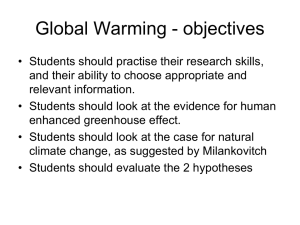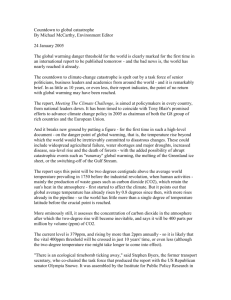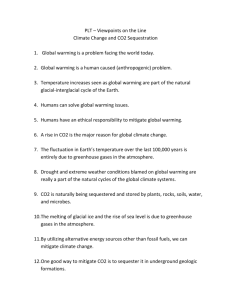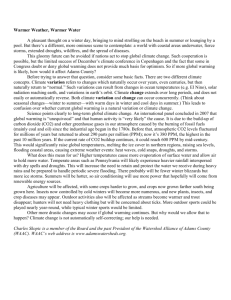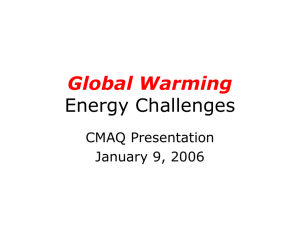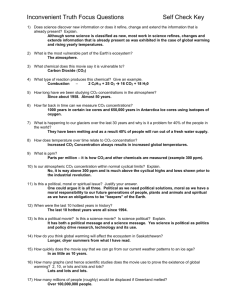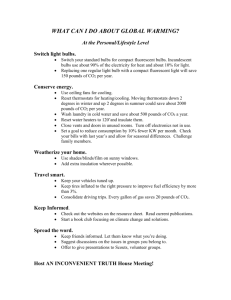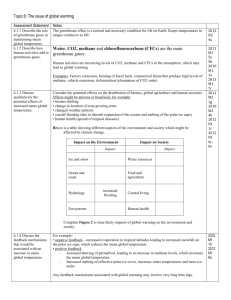6th_301M-Lecture
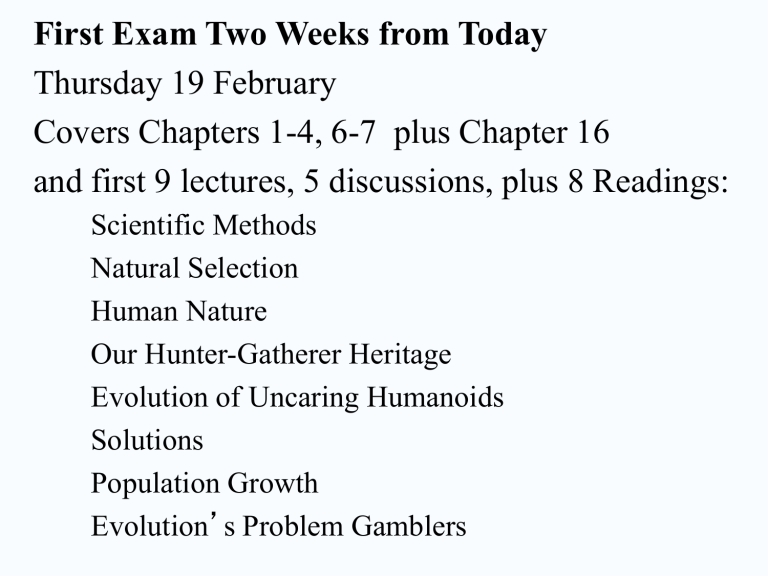
First Exam Two Weeks from Today
Thursday 19 February
Covers Chapters 1-4, 6-7 plus Chapter 16 and first 9 lectures, 5 discussions, plus 8 Readings:
Scientific Methods
Natural Selection
Human Nature
Our Hunter-Gatherer Heritage
Evolution of Uncaring Humanoids
Solutions
Population Growth
Evolution ’ s Problem Gamblers
Big Bang 13.7-13.8 billion years ago
Life arose 3.5 billion years ago
Anaerobic versus aerobic bacteria, fermentation, respiration
Photosynthetic prokaryotes, origin of oxygen atmosphere
Endosymbiosis: origin of eukaryotes, plants, fungi, and animals
Reticulate Evolution: Mitochondria, Chloroplasts
Phylogenetic Systematics = cladistics, clades
Importance of shared derived characteristics (synapomorphies)
Monophyletic groups (Polyphyletic, Paraphyletic)
Sister groups, outgroups
Rooting phylogenetic trees
Infer/identify ancestral states — polarize character state changes
Hierarchical classification, Latin binomial nomenclature
Pongid ( “ Hominid ” ) phylogeny, blood group types
Organisms are classified hierarchically
5 Kingdoms: plants, animals, fungi, protists, bacteria
• Phylum Arthropoda
• Class
• Order
Insecta
Diptera
• Family Drosophilidae
• Genus Drosophila
• Species melanogaster
• Chordata
• Mammalia
• Primates
• “ Hominidae ” (Pongidae)
• Homo
• sapiens
(the “ sap ” )
Mabuya Egernia
Eremiascincus
Ctenotus
N
A
Pongidae
Dance, Monkeys, Dance by Ernest Cline: http://www.youtube.com/watch?v=a15KgyXBX24
Pongid Phyogeny
Prosimian
Humans could have been stewards of Earth and all its many denizens, microbes, plants, fungi, and animals. We have the ability to have been God-like. Instead, for a short-sighted and selfish transient population boom, we became the Scourge of the planet. We wiped out and usurped vast tracts of natural habitat. We ate any other species that was edible and depleted all Earth
’ s multitude of natural resources. In a single century, humans burned fossil fuels that took millions of years to form.
Humans fouled the atmosphere, despoiled the land, and poisoned the waters, making the planet uninhabitable even to ourselves.
We trashed the life support systems of this, our one and only Spaceship, planet Earth.
The disparity between what humans could have been versus the pitiful creatures we actually managed to become is tragic and unforgivable.
If only more people would live up to their full potential!
Excerpts from Homer Smith (1952) “ Man and His Gods ” and Lord Earl of Balfour (1895) “ Foundations of Belief ”
Man did not have forever to harness the forces of the sun and stars. The
Sun was an elderly light, long past the turbulent heat of youth, and would some day join the senile class of once-luminiferous bodies. In some incredibly remote time a chance collision might blow it up again into incandescent gas and start a new local cosmic cycle, but of man there would be no trace. In Balfours's terms, he “ will go down into the pit, and all his thoughts will perish. The uneasy consciousness, which in this obscure corner has for a brief space broken the contented silence of the universe, will be at rest. Matter will know itself no longer.
‘ Imperishable monuments ’ and ‘ immortal deeds, ’ death itself, and love stronger than death, will be as though they had never been. Nor will anything that IS be better or be worse for all that labour, genius, devotion and suffering of man have striven through countless generations to effect.
”
(Italics added)
Greenhouse Effect
Global warming
• CO
2 pollution of the air
– Burning oil, deforestation
• Greenhouse gases cause warming
• Water vapor, H
2
O
• Carbon dioxide, CO
2
• Nitrous Oxide, N
2
O N=N=O
• Methane, CH
4
= 25 molecules CO
2
• Trifluoromethyl Sulfur Pentaflouride, SF
5
CF
3
= 18,000 molecules CO
2
(half life = 1,000 years)
AVERAGE global temperatures are increasing.
– Ocean temperatures and acidity
– Sea levels rising
– Glaciers and ice caps melting
2013 396 ppm
Warming by Decade
James Hansen
Science , 1431 (2005); 308
James Hansen, et al.
2013 1824 ppb
2013 396 ppm
Milankovitch Cycles
Interglacials
2013 1824 ppb
2013 396 ppm
“The Long Summer”
° C
° C
° C
° C
° C
H
|
Methane Clathrates and Hydrates
H— C — H + O
2
|
H
—> CO
2
+ H
2
O
H
|
H— C — H
|
H
H
|
H— C — H
|
H
An international consortium involving Canada, the US,
Japan, India, and Germany
Fracking for Natural Gas
H
|
H— C — H
|
H
Methane Emissions
Global warming may be slowing deep ocean currents
Milankovitch Cycles
Precession: At present, earth is closest to sun during winter in the northern hemisphere (11,000 years ago it was closest to the sun during summer in the northern hemisphere) (22,000 year cycle). Orbit itself shifts: Aphelion<——> Perihelion
Obliquity: Angle of inclination varies cyclically from
22 ° to 24.5
° with a periodicity of about 41,000 years
(currently about 23.5
° )
Eccentricity: Earth ’ s orbit changes from relatively circular to more elliptical and back again over a 95,000 year cycle.
Milutin
Milankovitch
Watch “TempFast.mov” 128 years go by in one minute!
1.74 times the area of Texas
Warming stresses ecosystems
• Coral reefs, tundra, Arctic
3.5 kilometers per year.
2030
The Big Apple finally goes under

